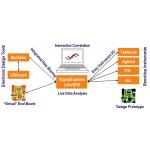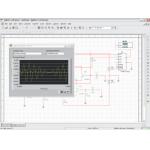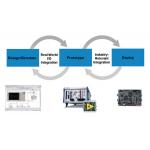Latest News
February 1, 2006
By Braulio Lam and John Olley
While design verification and circuit simulation are two of the most essential and critical elements of the design process, engineers do not have to view them as distinct and unrelated stages in the development process. Most engineers recognize that integration of design and test would improve product development, but they feel that the disconnect between disparate tools for each phase limits them.
Electronics Workbench and National Instruments now offer integrated design and test software through the Multisim virtual benchtop. Electronics Workbench’s Multisim fully integrates with National Instruments’ LabVIEW and SignalExpress to deliver a streamlined approach to benchtop electronics design. With integrated software throughout the design flow, circuit simulation, and with the ability to include real-world measurements early in the design process, the virtual benchtop offers engineers a solution that bridges the traditional disconnect between design and test tools. This tutorial explains how designers can leverage this integrated design solution to increase productivity and reduce time-to-market.
Design and Verification Today
Traditionally, circuit design consists of schematic capture and some circuit simulation. An engineer then manufactures and verifies a prototype board using traditional benchtop devices, such as oscilloscopes and spectrum analyzers.

‹‹ Figure 1: Today’s virtual benchtop has evolved to include automation tools that overcome the limitations of the traditional benchtop and maximize productivity in the simulation and verification phases of the design cycle.
If the design verification results are unsatisfactory, the engineer makes changes and repeats the “design—simulation—prototype—verification” process. Typically, this approach requires multiple design iterations before an acceptable prototype is achieved.
When a design engineer decides to simulate before prototyping with typical EDA (electronic design automation) tools, they usually run into such limitations as the lack of reliable models and/or simulation performance. Additionally, traditional benchtop instrument manufacturers generally do not provide the functionality required to easily and seamlessly integrate the simulation and verification environments.
This disconnect between design and test manifests itself in various ways; e.g., test instruments often lack flexibility or customization. Often engineers are unable to pass simulation data to their measurement tools for easy comparison purposes. If there is a way to do this, it usually requires the design engineer to perform a number of manual steps to bring the data from one tool to the other and then compare the results. The lack of analysis and postprocessing capabilities in the traditional benchtop further contributes to long development cycles.
Virtual Benchtop
Today’s virtual benchtop (see Figure 1, above) has evolved to include tightly integrated EDA and electronic measurement automation (EMA) tools designed to overcome the limitations of the traditional benchtop and to maximize productivity in the simulation and verification areas of the design cycle.
As part of this evolution, EDA tools such as Electronics Workbench’s Multisim 9 offer the performance and reliability needed by design engineers who use simulation more and more as part of their design process. Thus, simulation is no longer an afterthought. Rather, design engineers embrace the concept and recognize it as an important phase in the design cycle that helps reduce cycle time and overall time-to-market.
With the Multisim and NI LabVIEW 8 and SignalExpress integration, an engineer can capture the real-world signals of hard-to- model devices, such as sensors and buses, and use these signals to drive a design during simulation. Engineers can use the TDM and LVM voltage and current sources in Multisim 9 to read native measurement files created in LabVIEW or SignalExpress directly. Using measured data as the source that drives simulation helps the design engineer determine how the design behaves in the presence of real-world signals and whether he or she needs to change the selected part or parts in the design to maximize performance.
|
|
| Figure 2: LabVIEW signal analyzer VI analyzing data in Multisim 9. |
Another example of how today’s virtual benchtop closes the gap between simulation and test is the use of simulated data to drive external circuitry. For example, an engineer can export simulation results from Multisim’s instruments or grapher in either .tdm or .lvm native file formats and seamlessly import them into LabVIEW or SignalExpress. They can do this without even sampling the simulation data (a previous requirement) because Multisim automatically performs the resampling during the export.
Once the simulated data is imported, an engineer can use it as another signal in a larger test environment or as the signal that drives a prototype circuit board through a data acquisition card connected to the PC. Almost immediately, the design engineer can see how the prototype board behaves under different circumstances (which is determined by simulation results from the circuit design).
One of the major advantages of the virtual benchtop is the flexibility design engineers have to create fully customizable VIs (virtual instruments) using LabVIEW 8 for analyses and testing purposes. They can use these customizable virtual instruments in the Multisim 9 environment as a supplement to the 20 instruments supplied with software.
For example, a design engineer can create a LabVIEW VI that reads real-world data directly from a microphone through the PC sound card. Engineers can then use the identical VI in Multisim to drive the simulation of a circuit design. Similarly, engineers can use LabVIEW to create instruments that analyze simulation data and display the results directly in the Multisim environment (see Figure 2, above).
The Future of Design and Verification
While these examples show the advances of the virtual benchtop, they also show that EDA and EMA developers are closing the design and test gap to give design engineers tools that seamlessly integrate the design and test phases of the development cycle. Today’s virtual benchtop represents the beginning of the road that lies ahead.
Developers of EDA and EMA software will continue to work toward the seamless integration of the design and verification phases of the development cycle (see Figure 3, below). Closer integration of these tools will result in the parts selection, simulation, and verification phases of the development cycle becoming more tightly coupled, further decreasing the frequency of design iterations.
|
|
| Figure 3: Integration between EDA and EMA tools. Closer integration of these tools will result in the parts selection, simulation, and verification phases of the development cycle becoming more tightly coupled. |
In addition, EDA and EMA tool integration will facilitate the use of design in the verification environment, bringing verification into the design cycle at an earlier point, further shortening time-to-market. Similarly, the ability to simulate a design in its early stages using real-world signals in real time (for example, using a data acquisition card) will give the design engineer greater freedom to modify simulation models and properly select parts. This will shorten the design cycle and decrease time-to-market still more.
Braulio Lam is a quality assurance manager and John Olley is a technical writer for Electronics Workbench Corp. in Toronto, Ontario. You can send your comments about this article via e-mail by clicking here. Please reference Evolving Benchtop, February 2006” in your message.
Product Information
Multisim 9
Electronics Workbench Corp.
Toronto, ONT
LabVIEW 8, SignalExpress
National Instruments
Austin, TX
Subscribe to our FREE magazine, FREE email newsletters or both!
Latest News
About the Author
DE’s editors contribute news and new product announcements to Digital Engineering.
Press releases may be sent to them via [email protected].








